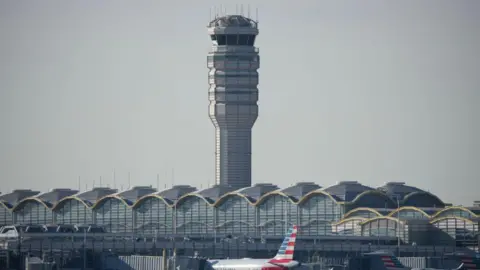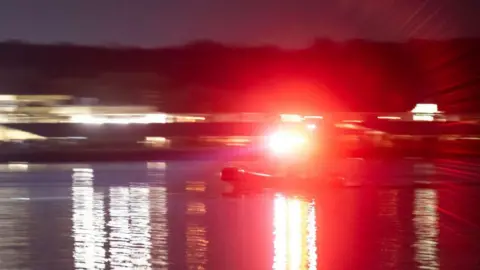'Woah that was close': Near-miss warning signs ahead of DC plane crash
 Getty Images
Getty ImagesPilot Mike Slack was in the cockpit during a descent into Ronald Reagan Washington National Airport nearly two decades ago when he noticed something on the runway.
Mr Slack, a licensed pilot and now aviation attorney, was sitting in the right pilot seat as his plane prepared to land on Runway 33 - the same runway the doomed American Airlines flight approached when it collided mid-air with a helicopter this week.
A departing Cessna Citation plane was pulling onto the runway to take off. His aircraft quickly aborted the landing, climbed back into the sky and began circling the airport to try again - a flight manoeuvre called a sudden go-around.
"That was one of those moments you go, 'Man that was close and that was tight,'" he told the BBC.
While near-misses at the airport and across the country are far from the norm, and fatal collisions are even rarer, Wednesday's crash, in which 67 people died, has renewed calls to re-evaluate safety protocols and shone a spotlight on air traffic at Reagan National airport.
"When something like this happens, typically it's something that's slipped past many safeguards," said retired air-traffic controller Ron Bazman, whose son, wife and brother have also all worked as controllers. "Rarely is it a smoking gun."
The cause of the collision is still being determined, but media and the White House have zeroed in on actions taken by the helicopter and on air traffic control staffing on the night of the crash as they speculate on what went wrong. It is the worst mid-air collision in America since the 1980s.
MIT aeronautics professor R. John Hansman said that it's important to take stock of safety concerns, but also to recognise that the American aviation system is one of the safest in the world.
"This was terrible," he said, noting there hasn't been a major commercial plane crash since 2009. "But it isn't like the system is falling apart."
Since his comments, a small medical transport plane crashed into buildings in Philadelphia on Friday evening, just two days after the Washington crash. The jet was carrying four crew members, a child patient and the patient's escort, Jet Rescue Air Ambulance said in a statement.
The FAA and National Transportation Safety Board (NTSB) are investigating the crash. In a statement, President Donald Trump said: "So sad to see the plane go down in Philadelphia, Pennsylvania. More innocent souls lost."
What happened at Reagan National airport?
An American Airlines flight that had departed from Wichita, Kansas, was coming in for a landing when it collided with a Sikorsky H-60 Black Hawk helicopter on Wednesday evening. The army helicopter had taken off from Fort Belvoir, close by in Virginia, on a training mission.
Recordings of air traffic control conversations published online suggest that a controller warned the helicopter about the jet in the seconds before the collision. The helicopter pilot appeared to confirm they were aware of the plane, but moments later the two aircraft collided.
Located in Virginia at the heart of the capital area, the airport has become exceptionally popular with travellers, but it faces numerous logistical challenges, such as congestion in the air space and shorter runways.
With nearly 400 flights daily, it provides direct service to 98 destinations in the US and Canada and is a feeder airport to international hubs in areas like Philadelphia, Charlotte, Atlanta and New York.
Several pilots the BBC spoke with said that flying in and out of the small airport on the edge of the US capital can be a nail-biting experience.
"There are times when we are watching planes land and we find ourselves saying 'whoa that is close'," said pilot Mo Khimji, noting that strong crosswinds can push a plane into restricted airspace "by a whisker" if the pilot is not careful.
Multiple types of aircraft share the airspace, from Air Force One carrying the president to commercial flights and military helicopters. And at night, city lights reflect off the Potomac River, making visibility and spotting other aircraft even tougher.
It is also smaller than other airports, such as nearby Dulles International Airport, with Mr Slack calling it a postage stamp.
"It's a challenging arrival, challenging approach. You've got traffic all around you - above, below and to each side," he said.
Near misses spark safety review
Mr Slack's experience of a near-miss is not an isolated incident. Just 24 hours before the deadly collision, a military helicopter came too close to a different regional jet, which then performed a sudden go-around, according to a list of incidents and accidents from the FAA.
After several national incidents in 2023, the Federal Aviation Administration (FAA) ordered a safety review warning that "one close call is one too many".
The review raised alarms.
"Inadequate, inconsistent funding", as well as staffing shortages, had led to an "erosion" of safety standards that made "the current level of safety unsustainable", it found.
Chronic air traffic control staffing shortages impact the FAA's ability to maintain safety standards, the 2023 safety review found.
Last year, the agency barely exceeded its hiring target of 1,800 controllers - by 11. But the 2023 review found those very targets were insufficient to "adequately satisfy system needs".
Prof Hansman said staffing issues have been a "perpetual" concern, as waves of employees have retired. Mr Bazman, the retired air traffic controller, said Covid made a lot of staffing issues worse.
"It's a domino effect, it really is," he said.
Training for the highly specialised job of safely guiding aircraft, often full of people, into the air and onto the ground can take as long as three years.
When staff is short, available workers are put into the most critical positions and some roles go unfilled.
Prof Hansman cautioned against blaming the controller shortage for the recent collision, saying: "There is no indication that there was a controller incompetency issue."
Political influence impacts change
With the budget for the FAA determined by Congress - and the leader of the FAA appointed by the president and confirmed by the Senate - the organisation can sometimes fall prey to the ups and downs of Capitol Hill, the safety review found.
The chronic controller shortage was made worse when a 35-day US government shutdown that started in 2018 put a pause on hiring.
Political pressure has also impacted Reagan, specifically.
Last year, US lawmakers tried to add landing spots there through the FAA's budget reauthorisation just two weeks after a near-miss at the airport - a move Virginia Senator Tim Kaine opposed.
"We should not be jamming more flights onto the busiest runway in the United States," Kaine told fellow lawmakers.
 Getty Images
Getty ImagesThen, there is the steady rotation of people at the top, in the role of FAA administrator. In three years, the agency has had just as many administrators.
When the American Airlines jet and helicopter collided on Wednesday, there was, in fact, no FAA administrator.
The Biden-appointee Michael Whitaker had resigned in December, just one year into his five-year term. Media reported the early departure was spurred by an adviser to President Donald Trump, Elon Musk, who had called for Whitaker's resignation after the FAA proposed fining his rocket company SpaceX $600,000 for alleged launch violations.
While Trump has named an acting administrator in the wake of the crash, the permanent administrator will need to go through a congressional approval process.
Prof Hansman said the rotating door of administrators makes it harder to make substantive changes or improvements.
"It keeps keeping on, it keeps operating the way it has," he said.
But after Wednesday's crash, change should be expected, Todd Inman, of the National Transportation Safety Board (NTSB), told media Friday evening.
"Our job is to find the facts. More importantly, our job is to make sure this tragedy doesn't happen again - regardless of what anyone may be saying," he said.
"We will be advocating for years for changes that need to be made."
